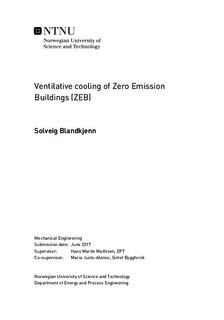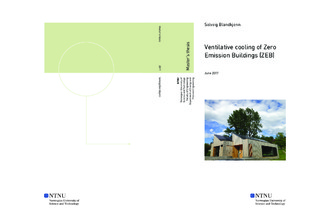| dc.description.abstract | Well-insulated buildings, like Zero Emission Buildings (ZEB), have a high occurrence of overheating even in cool climates. It is important to have cooling systems installed to achieve thermal comfort for the occupants of these buildings, but the high energy consumption of mechanical cooling makes it hard to reach a goal of Zero Emission. This master s thesis investigates the possibility to use natural ventilation principles to supply ventilative cooling in a Zero Emission Building in a cool climate. The focus has been to supply natural ventilation through window openings without causing local thermal discomfort like draught - but still succeeding in cooling down the building. Natural ventilation can be used instead of mechanical ventilation to remove pollutants like CO2. The energy saving potential of using only natural ventilation when the weather conditions allow it has also been evaluated in this thesis.
Living Lab is a ZEB built on the NTNU campus in Trondheim, and has been the subject of this thesis. Experiments have been conducted in the building to determine how natural ventilation can be used without causing local thermal discomfort. A control algorithm for ventilative cooling supplied by the windows has been proposed - based on experiments, findings in literature and previous studies of Living Lab. An IDA ICE building simulation model has been used to develop ventilative cooling strategies and evaluate them based on thermal comfort, indoor air quality and energy consumption.
Climatic limits for when natural ventilative cooling can be supplied in Living Lab has been chosen for the present window design. When using these limits in a control algorithm, simulations showed that thermal comfort could be achieved for 98.9 % of the annual hours of occupancy, with only a 0.6 % annual increase in energy for heating. Simulations with other window designs showed that it was possible to improve the cooling effect and energy efficiency by applying ventilative cooling in more rooms at the same time, but the energy consumption for heating was still increased by 0.4 % per year. It was possible to reduce the total energy consumption for heating and ventilation by using natural ventilation alone when the outdoor conditions allowed it. If the mechanical ventilation system was turned off when outdoor temperatures exceeded 14 °C, thermal comfort and good indoor air quality was achieved, while the total energy consumption for heating and ventilation was reduced by 2.2 % per year. | |

